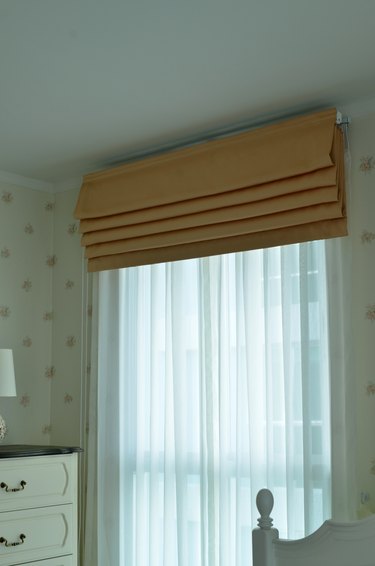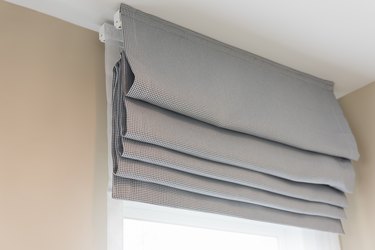Shades and blinds must fit precisely to a window's measurements only if they are installed inside the window frame or opening. This is called an inside mount. If the shades are installed outside of the window opening — called an outside mount — the shades typically are wider than the window by a few inches and can also be longer than the window. Each type of mounting has its own considerations and steps for measuring.
Tip
When measuring your window for new shades, keep these tips in mind. For the best fit, make sure to use a metal tape measure because a cloth one may stretch and give you an inaccurate reading. Remember to measure each window separately even if they look identical (they might not be!). And finally, measure your window — not your existing blind or shade — to get the right size for your window.
Video of the Day
Choosing a Mounting Style
Shades and blinds with an inside mount offer a clean look because the shade fits closely inside the window opening and does not cover any of the window trim (casing) or the window sill. The shade itself is relatively flush with the trim or wall, allowing you to add drapes, panels or curtains over the shade, if desired.
Video of the Day

Due to the close fit, an inside mount works well when the window is square (has 90-degree corners, not square in overall shape) and the window frame provides sufficient depth for the shade. Depending on the style of shade, the window frame may need 1 ½ to 3 inches or more of depth to accommodate the shade's head rail.
An outside mount offers more installation options than an inside mount. Outside mount shades or blinds can be installed onto the window casing, onto the wall at the side or above the window, and even onto the ceiling. The shade can cover some or all of the window trim or sill, and it can extend above and below a window (a decorating trick to create the illusion of larger windows).

Because an outside mount shade overlaps the window opening, it typically blocks light better than inside mounts. The main disadvantages of an outside mount are that it obscures the window trim and it extends beyond the plane of the window or wall.

How To Measure a Window for Inside Mounting
An inside mount shade or blind must fit the window measurements very closely. For this reason, window shade manufacturers always ask you to measure the width and height of the window opening in three different places. For the shade width, measure straight across the window opening at the top, center and bottom of the opening, and note the smallest measurement. For the shade height, measure vertically between the top of the opening and the windowsill, at the left, center and right of the opening; record the longest measurement.
When ordering shades or blinds from a manufacturer, provide the exact measurements of your window. The manufacturer will subtract the appropriate amount (typically ¼-inch) from the width of the shade or blind, so it won't rub along the sides of the window frame or opening. A manufacturer may also want to know the depth of the window frame, or the distance between the front face of the casing and the inside face of the window frame.
How To Measure a Window for Outside Mounting
Shades or blinds mounted outside the window frame typically extend beyond the window casing at the sides and cover the casing at the top of the window, but they can overlap the casing as little or as much as you like. If the windowsill projects from the wall, the shade usually stops at the top of the sill. Alternatively, the shade can extend below the sill if the sill won't interfere with the shade's movement.
Sizing a shade or blind for an outside mount is mostly an aesthetic decision, but there are a few measurements to check before settling on a size. Measure between the top of the window and the ceiling (or ceiling molding) to make sure there is enough room for mounting the shade. Do the same at both sides of the window, measuring between the window and any adjacent walls, windows or doors. Finally, to ensure light control and privacy, the shade should be at least 3 inches wider than the window opening, so it overlaps the window by 1 ½ inches at each side.